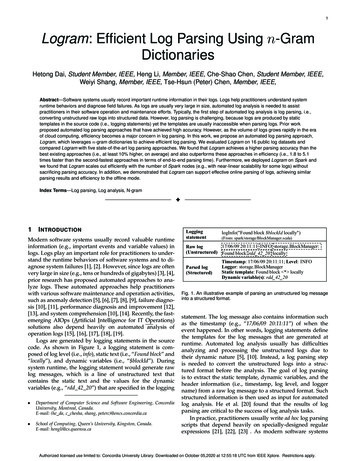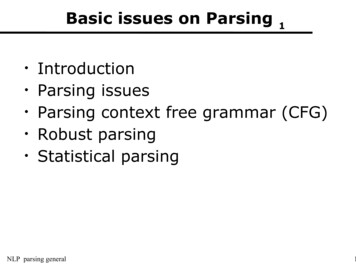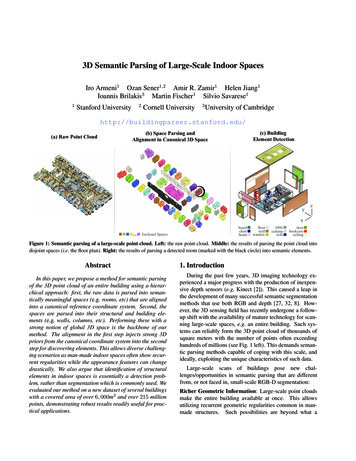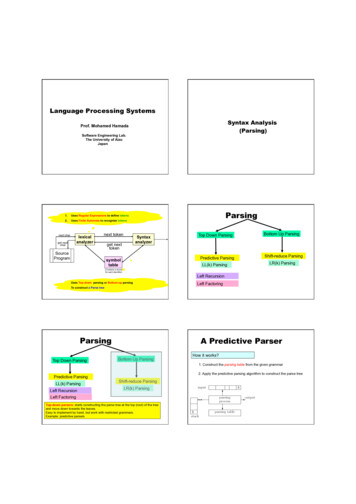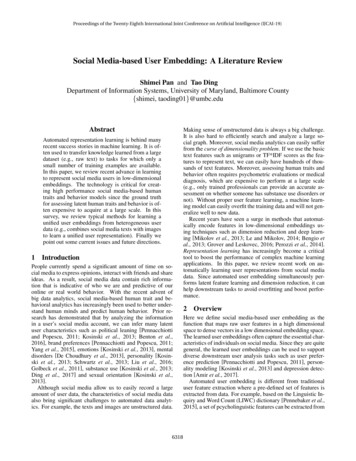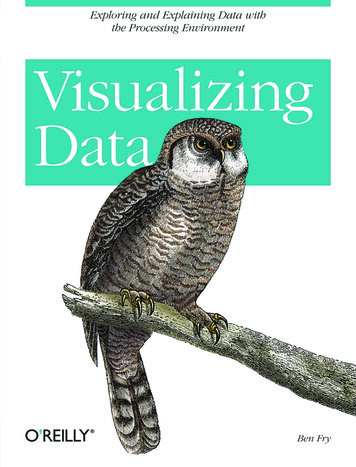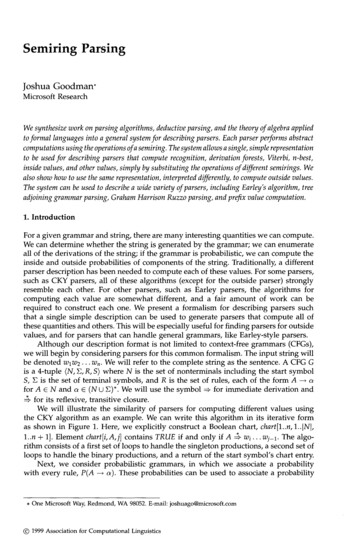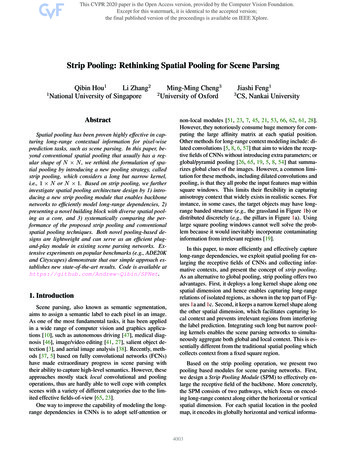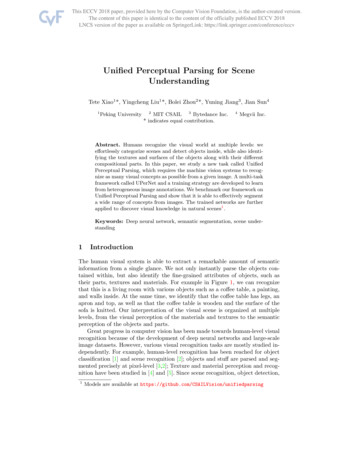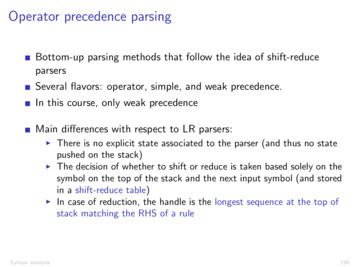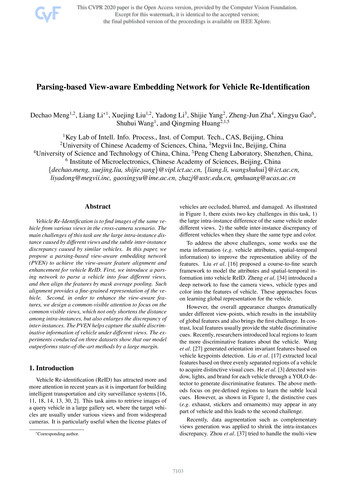
Transcription
Parsing-based View-aware Embedding Network for Vehicle Re-IdentificationDechao Meng1,2 , Liang Li* 1 , Xuejing Liu1,2 , Yadong Li3 , Shijie Yang2 , Zheng-Jun Zha4 , Xingyu Gao6 ,Shuhui Wang1 , and Qingming Huang2,1,51Key Lab of Intell. Info. Process., Inst. of Comput. Tech., CAS, Beijing, ChinaUniversity of Chinese Academy of Sciences, China, 3 Megvii Inc, Beijing, China4University of Science and Technology of China, China, 5 Peng Cheng Laboratory, Shenzhen, China,6Institute of Microelectronics, Chinese Academy of Sciences, Beijing, China{dechao.meng, xuejing.liu, shijie.yang}@vipl.ict.ac.cn, {liang.li, wangshuhui}@ict.ac.cn,liyadong@megvii.inc, gaoxingyu@ime.ac.cn, zhazj@ustc.edu.cn, qmhuang@ucas.ac.cn2AbstractVehicle Re-Identification is to find images of the same vehicle from various views in the cross-camera scenario. Themain challenges of this task are the large intra-instance distance caused by different views and the subtle inter-instancediscrepancy caused by similar vehicles. In this paper, wepropose a parsing-based view-aware embedding network(PVEN) to achieve the view-aware feature alignment andenhancement for vehicle ReID. First, we introduce a parsing network to parse a vehicle into four different views,and then align the features by mask average pooling. Suchalignment provides a fine-grained representation of the vehicle. Second, in order to enhance the view-aware features, we design a common-visible attention to focus on thecommon visible views, which not only shortens the distanceamong intra-instances, but also enlarges the discrepancy ofinter-instances. The PVEN helps capture the stable discriminative information of vehicle under different views. The experiments conducted on three datasets show that our modeloutperforms state-of-the-art methods by a large margin.1. IntroductionVehicle Re-identification (ReID) has attracted more andmore attention in recent years as it is important for buildingintelligent transportation and city surveillance systems [16,11, 18, 14, 13, 30, 2]. This task aims to retrieve images ofa query vehicle in a large gallery set, where the target vehicles are usually under various views and from widespreadcameras. It is particularly useful when the license plates of* Correspondingauthor.vehicles are occluded, blurred, and damaged. As illustratedin Figure 1, there exists two key challenges in this task, 1)the large intra-instance difference of the same vehicle underdifferent views. 2) the subtle inter-instance discrepancy ofdifferent vehicles when they share the same type and color.To address the above challenges, some works use themeta information (e.g. vehicle attributes, spatial-temporalinformation) to improve the representation ability of thefeatures. Liu et al. [16] proposed a course-to-fine searchframework to model the attributes and spatial-temporal information into vehicle ReID. Zheng et al. [34] introduced adeep network to fuse the camera views, vehicle types andcolor into the features of vehicle. These approaches focuson learning global representation for the vehicle.However, the overall appearance changes dramaticallyunder different view-points, which results in the instabilityof global features and also brings the first challenge. In contrast, local features usually provide the stable discriminativecues. Recently, researchers introduced local regions to learnthe more discriminative features about the vehicle. Wanget al. [27] generated orientation invariant features based onvehicle keypoints detection. Liu et al. [17] extracted localfeatures based on three evenly separated regions of a vehicleto acquire distinctive visual cues. He et al. [3] detected window, lights, and brand for each vehicle through a YOLO detector to generate discriminative features. The above methods focus on pre-defined regions to learn the subtle localcues. However, as shown in Figure 1, the distinctive cues(e.g. exhaust, stickers and ornaments) may appear in anypart of vehicle and this leads to the second challenge.Recently, data augmentation such as complementaryviews generation was applied to shrink the intra-instancesdiscrepancy. Zhou et al. [37] tried to handle the multi-view7103
In summary, our main contributions are three folds. To address the two key challenges in vehicles ReID,we propose a view-aware feature embedding method,where both feature alignment and enhancement ofcommon visible views help to learn more robust anddiscriminative features.(a) Vehicle ID-1 We introduce a common-visible attention to enhancefeatures under different views. This not only shortensthe distance among intra-instances, but also enlargesthe discrepancy of inter-instances.(b) Vehicle ID-2Figure 1. Toy examples from two different vehicles with the sametype and color in VERI-Wild. Each row indicates different viewsof the same vehicle, which shows the challenge of large intrainstance difference. Each column denotes the same view from different vehicles, which shows the challenge of subtle inter-instancediscrepancy. The red boxes represent the subtle discriminative differences of the two vehicles. Experiments on three vehicle ReID datasets verify theeffectiveness of PVEN1 . It achieves superior performance over SOTA methods with a large margin.2. Related Worksproblem based on generating the invisible views. The generated views are derived from the visible view, which areunable to reconstruct additional discriminative features.In vehicle ReID, different views usually present the different characteristics of a vehicle. We would acquire morediscriminative description of a vehicle by leveraging thesecomplementary characteristics. However, since the samevehicle has large appearance discrepancy between differentviews, how to effectively fuse such different characteristicsremains a challenging problem.To tackle the above challenge, this paper proposes aParsing-based View-aware Embedding Network (PVEN) toachieve the view-aware feature alignment and enhancement for vehicle ReID. The PVEN consists of three modules: vehicle part parser, view-aware feature alignment, andcommon-visible feature enhancement. First, we generatefour view masks (front, back, top and side) by training aU-shape parsing network as shown in Figure 3. Becausethe vehicle is a rigid body, the parsing network achievesan impressive accuracy as it need not handle the deformingproblem. Second, based on global feature maps, local viewaware features are aligned through mask average pooling.Such alignment brings the vehicle the fine-grained representation with a complete spatial covering. Third, we proposea common-visible attention to enhance the local features.The mechanism tends to enlarge the effect of common visible views between two vehicles and suppress the non-salientviews. This helps to overcome the large intra-instance difference under different views and the subtle discrepancyof inter-instances under similar type and color. Based oncommon-visible attention, we modified the typical tripletloss to avoid the mismatch of local features. We optimizethis local triplet loss and the global loss to learn the viewaware feature embedding. As a result, the global semanticand local subtle discriminative cues are jointly learned intothe final embedding of the vehicle.Vehichle Re-identification has become a hot topic recently due to its wide using in intelligent transportation systems [16, 11, 18, 14, 2, 19, 8]. In previous works of vehicleReID, these methods can be summarized into three groups:(1) Vehicle meta-information based feature fusion. Themeta information, such as spatial-temporal information,vehicle attribute, are aggregated into global vehicle embeddings. Liu et al. [16] used a course-to-fine progressive search to leverage the vehicle attributes and spatialtemporal information. Shen et al. [24] considered the constraint of spatial temporal information and used visualspatial-temporal path to reduce searching space. Guided bycamera views, vehicle types and color, Zheng et al. [34] introduced a deep model to fuse the features for vehicle ReID.These approaches learn global representation for vehicle,and they are sensitive to dramatic changes of view. So theysuffer from the challenge of large intra-instance differenceof the same vehicle under different views. (2) Local regionbased vehicle feature learning. Besides global features, recent works take advantage of local features to improve therepresentation ability. For example, Wang et al. [27] generated orientation invariant feature based on pre-defined keypoints detection. He et al. [3] used the local region (e.g.,window, brand and light bounding box) to learn more discriminative regions. This type of methods usually dependson pre-defined distinctive region or key-points. They ignore the fact that the discriminative cues may appear in anyregion of vehicle, and suffer from the challenge of subtleinter-instance discrepancy of similar vehicles. (3) Generative Adversarial Network based feature alignment. WithGAN thriving, some works have started to introduce GANinto vehicle ReID. For instance, Zhou et al. [37] handledthe viewpoint problem by generating the opposite side features using a GAN. Lou et al. [18] proposed to generate the1 https://github.com/silverbulletmdc/PVEN7104
Global feature extractionCNNID scoresTraining StageGlobalaverageFeature mappoolingBNfcID LossGlobal lossTriplet LossView-awarefeaturesU-NetTriplet LossMaskaveragepoolingLocal ibilityscoreCommon visiblefeature enhancementVehicle part parserView-awarefeature alignmentGlobalDistanceInference StageFigure 2. The network architecture of PVEN. First, the image is fed into feature extractor and vehicle part parser. The former outputssemantic feature maps while the latter generates the view mask of front, back, top and side. Then global feature of vehicle is extractedto construct the ID loss and triplet loss. View-aware features are extracted by mask average pooling for each mask. We aggregate thefeatures by common-visible attention to formulate the triplet loss of local features. In inference stage, the distance of global feature andlocal features are added to get the final distance.hard samples by introducing a GAN. Due to the limitationof generation ability of existing GAN and the insufficientadversarial samples, there exists large gap between the generated features and reality features.Vehicle re-identification is also related with person ReIDtask, which aims to find target persons from various viewsin a large set of persons. Recently, CNN-based featuresachieved great progress on person ReID [25, 35, 6, 20, 33, 9,32, 12]. Sun et al. [25] split the image with a uniform partition strategy and extract CNN features for each parts. Zhaoet al. [33] decompose the person by human body region toacquire human pose information. Wei et al. [9] proposedharmonious attention CNN to jointly learn attention selection and feature representation. The explosion of personReID methods lightens the vehicle ReID task.3. MethodologyTo address the challenges of large intra-instance difference and subtle inter-instance discrepancy in vehicle ReID,we propose a Parsing-based View-aware Embedding Network (PVEN). It consists of three modules: vehicle partparser, view-aware feature alignment, and common-visiblefeature enhancement. The PVEN focuses on the viewaware feature learning, where the alignment and enhancement of common visible regions helps learn more robustand discriminative features.3.1. Vehicle Part ParserAs one key challenge of vehicle ReID, view transformation under multiple cameras is unavoidable. Invariant fea-ture learning under different views is an important insightto improve the performance of vehicle ReID. We notice thatmost vehicles have the following two characteristics. First,the vehicle can be regarded as a cube, which can be dividedinto different parts by view. Second, the vehicle is the rigidbody, so there are no physical deformations. The characteristics imply that accurate vehicle parsing masks are capableto be extracted. With these parsing masks, we can aligncorresponding parts for different vehicles.A vehicle can be roughly regarded as a cube with sixsurfaces. The bottom of vehicle is usually invisible underthe camera. The left and right side of the vehicle usuallycan not appear at the same time under a certain view andare usually symmetry in visual. Based on these observations, we parse a vehicle into four parts: front, back, sideand top. The side indicates the left or right side of a vehicle. In this paper, the above parsing scheme is designed forvehicle view-aware representation. As shown in Figure 3,there are two key advantages of this parsing scheme: First,it covers the whole vehicle under the certain view, so thatevery subtle differences between two vehicles can be captured. Second, under most view-points, 3 parts of a vehicleare visible in an image, which means that there are at least2 same parts appearing in both the query and gallery image.Parsing Annotation for VeRi776 Dataset. We annotatea subset of VeRi776 [16] dataset for training vehicle partparsing network. To improve the adaptive capacity of theparsing model for various views, we collect as many viewsof a vehicle as possible. In detail, according the definitionof viewpoint in [27], we sample images for seven differentviewpoints of a vehicle. If the number of viewpoints is less7105
VeRi776visibilitymasks e masksVERI-WildFigure 3. Examples of our parsing result on three main vehicleReID datasets. The red, green, yellow and blue masks denote thefront, back, side and top view of the vehicle respectively.than four, we evenly sample four images of this vehicle.Totally, we annotated 3165 images. We select 2665 imagesof the annotated dataset randomly as training set and 500images as validation set.Vehicle Parsing Network. To get an accurate parsing result, we train a segmentation model [21] using the above annotated dataset. The parsing model takes SeResNeXt50 [5]as backbone and is trained with balanced cross entropy loss.Our model achieves 81.2% IoU score in the validation set,which is sufficient for solving the view transformation challenge. Figure 3 shows some of the parsing results in threevehicle ReID datasets. It shows the impressive generalization performance of the parsing model as the parser neednot handle the deforming problem.3.2. View-aware Feature AlignmentMost of vehicle ReID models use deep global featuresto represent a vehicle, which focus on learning high semantic information. In this paper, we introduce the view-awarelocal features to obtain the fine-grained representation witha complete spatial covering. Further, view-aware featurealignment is implemented to avoid the mismatch among different views.Here, we use ResNet50[4] pre-trained on ImageNet[22]dataset as our feature extractor. We reset the stride of lastpooling layer from 2 to 1 and obtain a 16 16 2048 feature map F. As shown in Figure 2, the feature extractor network has two output branches. The first branch is the globalbranch, where we apply the global average pooling to thefeature map to get global feature fg . The other branch is thelocal branch for view-aware feature learning. First, we poolthe above view masks to 16 16 by max pooling, whichis defined as {Mi i {1, 2, 3, 4}}. Second, we apply themask average pooling (MAP) to the feature map F to compute four local view-aware features {fli i {0, 1, 2, 3}}.They represent the front, back, side and top view of a vehi-Common-visible scoreView-awarefeaturesView-awarefeatureslocal distanceFigure 4. Illustration of common-visible attention. First, the visibility scores of different parts are computed based on the vehiclemasks. Then, the common-visible scores of all parts are obtainedby the common-visible attention. Finally, we calculate the localdistance between two vehicles with their view-aware features andthe corresponding common-visible scores.cle respectively. The fli is calculated byfli 16Mi (j, k) F(j, k) 16j,k 1 Mi (j, k)j,k 1(1)The global feature blend features of different views intoone feature. It leads to a mismatch of views when comparing two vehicles. Differently, the local view-aware featuresare aligned upon the above four views. It decouples theinformation of different views into corresponding local features, and provides view-aware embeddings for a vehicle.3.3. Common-visible Feature EnhancementAfter the above stage, we obtain the four view-aware local features fli of the vehicle. In this section, we introducea common-visible attention to enhance the features of different views. This helps capture the stable discriminativeinformation of the same vehicle under different views.Figure 4 shows the procedure of common-visible attention. Given two image p, q, and their masks Mip and Miq ,we compute the visibility score vip and viq , which indicatedthe size of corresponding area of each view. The visibilityscore vi is defined asvi 16 j,k 17106Mi (j, k)(2)
We introduce the common-visible attention to computeas following,the common-visible score ap,qivip viqap,q Nip qi 1 vi vi(3)where ap,qmeasures the consistency of common visible reigions. Then, the distance of local features D̂ between twovehicles is computed as,D̂p,q N pqapqi D(fi , fi )(4)i 1where D denotes the Euclidean distance.If the vehicle lacks some views, the correspondingcommon-visible score would be relatively small. So, onlyviews with high score would contribute to the final distance.In this paper, we optimize the network by constructingthe loss of ID and triplet loss for global features, and tripletloss for local features. The triplet loss of local features iscalculated based on the above distance of local features as,Lltriplet max(D̂ap D̂an γ, 0)(5)where the local distance based on view-aware feature alignment and common-visible feature enhancement aims to reduce the intra-instance distance from different views andenlarge the inter-instance distance from similar vehicles.Finally, the total objective of PVEN is to minimize thefollowing loss,L Lgid Lgtriplet Lltriplet(6)4. Experiments4.1. DatasetsWe evaluate our model on three popular vehicle ReIDdatasets, including VehicleID [11], VeRi776 [16] andVERI-Wild [18].VehicleID [11] is a large scale vehicle ReID dataset. Itcontains 221,763 images about 26,267 vehicles. Images ofthis datasets are captured under front or back viewpoint.Three test sets (i.e. small, medium and large) are extractedaccording to their size. During inference stage, for eachvehicle, one image is randomly selected as the gallery setwhile other images are regarded as query images.VeRi776 [16] is also a classical vehicle ReID benchmark. It consists of about 50,000 images of 776 vehicles,which are collected by 20 cameras across block region under different viewpoints. The training set covers 576 vehicles and the test set contains the other 200 vehicles.VERI-Wild [18] is another large scale dataset for vehicle ReID. It contains 416,314 images of 40,671 vehicles,which are collected by 174 cameras in a month.4.2. Experiments Setup4.2.1 TrainingWe train the parsing model for 40 epochs on our annotatedParsing VeRi dataset. The batch size is 8 and the learningrate is 1e-4. We use Adam as the optimizer. Finally, Theparser achieves 81.2% IoU score in the validation set.We train models for 120 epochs with warm-up strategy.Initial learning rate is 3.5e-5, which increases to 3.5e-4 after the 10th epoch, and drops to 3.5e-5, 3.5e-6 in the 40th,70th epoch for faster convergence. We first pad 10 pixels onimage border, and then randomly crop it to 256 256. Wealso augment the data with random erasing. Adam is usedto optimize the model. Further, we add a Batch Normalization layer after global feature. A fully connected layer isadded to map the global feature to ID classification score.4.2.2 InferenceTo evaluate our method, we first calculate the Euclideandistance Dglobal among global features. Then we calculate the distance D̂local as defined in Eq. (4) among localview-aware features. Final distance between query set andgallery set is computed as λ1 Dglobal λ2 D̂local . Here, weset λ1 1 and λ2 0.5.4.2.3 Compared MethodsWe compare our method with some state-of-the-art methods, e.g. (1). Handcraft feature based methods. BOWCN [36] first adopts BOW model based on the ColorName (CN). Local Maximal Occurrence Representation(LOMO) [10] is robust to the varied lightning conditions. Fusion of Attributes and Color feaTures (FACT) [15]combines the low-level color feature and high-level semantic features. (2). Deep learning based methods.GoogLeNet [28] is a GoogleNet[26] model fine-tuned onthe CompCars [29] dataset. Plate-SNN[16], which usethe number plate features to enhance the retrieval vehicles.Siamese Path [24] proposed the visual-spatial-temporalpath to exploit the temporal restrict. GSTE [1] proposedgroup-sensitive-triplet embedding to model the intraclassvariance elegantly. VAMI [37] generated features of different views by GAN while Feature Distance Adversarial Network [18] (FDA-Net) generated the hard negative samplesin feature space. EALN [19] proposed an adversarial network that is capable of generating samples localized in theembedding space. (3). Discriminitive region mining basedmethods. OIFE [27] used the 20 pre-defined keypoints toroughly align the vehicle features. RAM [17] split the image horizontally into 3 parts. PRN [3] detected the window,light and brand to capture the difference between vehicleinstances. AAVER [7] proposed an attention mechanismbased on vehicle keypoints and orientation.7107
Table 2. The mAP, CMC@1 and CMC@5 on VeRi776.MethodmAP CMC@1 CMC@5Table 1. The CMC@1 and CMC@5 on VehicleID.MethodMD 3]PVENsmall@1@50.490 0.7350.631 0.8330.752 0.9150.751 0.8810.747 0.9380.784 0.9230.847 0.970medium@1@50.428 0.6680.529 0.7510.723 0.8700.718 0.8390.686 0.9000.750 0.8830.806 78@50.6160.8290.7030.8450.8140.8560.8640.9204.3. Experiments on VehicleID datasetWe compare the CMC@1 and CMC@5 scores on thisdataset, as there is only one ground-truth for each query vehicle. Table 1 shows the comparison results on three testdatasets with different sizes. We observe that, first, compared with other methods, the PRN and our PVEN obtainedthe performance improvement with a large margin. This isbecause these two methods introduced the further learningto some key regions. This plays important role in vehicleReID task. Second, our PVEN achieve the improvement atthe CMC@1 by 3.6% and CMC@5 by 4.5% over theSOTA PRN [3] on different test data. Although the PRN [3]introduced the detection about window, light, and brand foreach vehicle, they ignored the fact that the distinctive cueswill appear in any part of vehicle. On the contrast, ourmethod certifies the complete information mining of vehiclethrough the local view-aware feature embedding. The abovecomparison results prove the effectiveness of the PEVN.It is worth noting that the vehicle only contains two viewpoints in this dataset, namely, the front side and back side.The extracted features from different views are completelydifferent, even they are from the same vehicle. Benefitingfrom view-aware feature enhancement, the PVEN can avoidthe mismatch of local features under the different views.4.4. Experiments on VeRi776 datasetWe also evaluate the vehicle ReID methods on VeRi776dataset, where three measurement metrics, including mAP,CMC@1 and CMC@5, are adopted.Table 2 shows the performance comparison amongPVEN and other methods. We find that, benefitting fromlearning of extra key regions, both the PRN and our PVENachieve a large promotion with a 16.0% and 21.2% on themAP respectively. Besides, different from the pre-definedregions of the PRN, the PVEN extracts the local informationfrom four views, which completely cover the whole vehicle.Thus, PVEN can learn the key distinctive and local cues todetermine the target vehicle. In detail, the PEVN obtainsthe improvement of 5.2% on mAP, and 1.3% CMC@1 overthe PRN. Moreover the CMC@5 of both methods have exceeded the 98.4%, which is a promising performance forreal vehicle ReID CT Plate STR[16]Siamese 9400.9410.9470.989PVEN0.7950.9560.984Table 3. The mAP on 6974.5. Experiments on VERI-Wild datasetVERI-Wild dataset[18] is the current largest vehicleReID dataset. Here we compare our PEVN with other methods at three metrics, namely, CMC@1, CMC@5 and mAP.Table 3 shows the performance of mAP on the three different size of test dataset. We can find that our PVEN hasa large promotion over the previous works of vehicle ReID.In detail, the improvement of mAP is 47.4%, 47.2%, and46.9% on the small, medium and large dataset respectively.This impressive boost of mAP benefits from the view-awarefeature alignment and enhancement, which help to learnmore robust and discriminative features of vehicles.Table 4 shows the performance of CMC@1 andCMC@5 from different methods on three test datasets. Wecan observe that, first, our PVEN exceeds all the other models under both metrics on different test datas. The CMC@1of the PVEN has the improvement of 32.7% than the FDANet [18], and the CMC@5 of PVEN has the improvementof 16.4% than FDA-Net. The consistency of CMC promotion proves the effectiveness of our model. Second, asthe size of test datas increases, the performance of the traditional methods decreases with a large margin. For example, for CMC@5, the state-of-the-art method FDA-Net de-7108
Table 6. The validation of parsing module on VeRi776.Table 4. The CMC@1 and CMC@5 on ]CCL[11]HDC[31]GSTE[1]Unlabled Gan[38]FDA-Net[18]PVENsmall@1@50.572 0.7510.447 0.6330.534 0.7500.570 0.7500.571 0.7890.605 0.8010.581 0.7960.640 0.8280.967 0.992medium@1@50.532 0.7110.403 0.5900.462 0.6990.519 0.7100.496 0.7230.521 0.7490.516 0.7440.578 0.7830.954 .978CMC@1CMC@5CMC@10PVEN w/o localPVEN w/o 0.987clines 4.5% between small and medium test data and 7.8%between medium and large test data; the performance ofPVEN degrades 0.4% between small and medium test dataand 1.0% between medium and large test data; This indicates that our approach has the better generalization abilityunder large datas. This results from the view-aware features enhancement under different views in PVEN, not onlyshortens the distance among intra-instances, but also enlarges the discrepancy of inter-instances.4.6. Ablation Study4.6.1The effectiveness of the parsing moduleTo validate the effectiveness of the parsing model for vehicle ReID, we conduct an experiment that just evenly splitthe images vertically into four parts, and remain other settings the same with PVEN. The results in Table 6 shows thatparsing performs better than both the baseline and verticalsplit settings in mAP and CMC@5.4.6.2The validation of view-aware feature learningWe conduct ablation study about the proposed view-awarefeature learning on VehicleID dataset. PVEN w/o local indicates the PVEN model without the local branch of viewaware feature learning. PVEN w/o CV-ATT adds the localbranch, but do not use the common-visible attention. It calculates the Euclidean distance of each local features. Typical triplet loss are applied to the distance. PVEN uses thefull architecture as described in Section 3. As in Table 5,first, we observe that our PVEN achieves better accuracythan others by a large margin. This is because view-awarefeature alignment and common-visible attention drives thenetwork attending to the common visible parts between twocompared vehicles. Second, directly applying triplet lossto view-aware features without common-visible attention ismAPCMC@1CMC@5baselinevertical 740.984Table 7. Weight selection of global and local distance on VeRi776.Table 5. Ablation study about each part of PVEN on .9840.9670.9900.9920.9920.9920.9910.982harmful to the performance. It treats features of each viewequally and ignore that features are non-salient under certain views, so this introduces noise to the network.4.6.3 Weight selection of global and local distanceHere we conduct experiments to figure out how the viewaware feature affects the performance of vehicle ReID. Table 7 shows the results of different weights between globaland local distance. We can find that the view-aware localfeature brings the improvement of final results at all metrics, namely mAP, CMC@1, CMC@5, CMC@10. Thelocal view-aware feature learning helps the global featureslearn better.4.6.4 Visualization of view-aware feature learningTo better understand the influence of view-aware featurelearning in PVEN, we visualize the distance heatmap ofvehicle images. The pixels with high score in distanceheatmap indicate that they play more important role in determine the similarity between query and gallery vehicle.Specifically, the heatmap is the weighted sum of the lastfeature maps of the backbone. The weights are computedfrom the element-wise Euclidean distance of two features.Figure 5 shows the distance heatmap of two images fromour PVEN and PVEN wi
U-shape parsing network as shown in Figure 3. Because the vehicle is a rigid body, the parsing network achieves an impressive accuracy as it need not handle the deforming problem. Second, based on global feature maps, local view-aware features are aligned through mask average pooling. Such alignment brings the vehicle the fine-grained represen-
